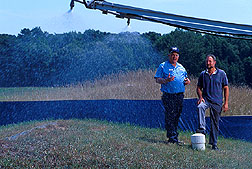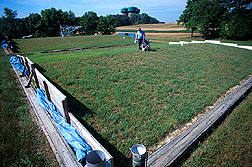Tracking Manure-Borne Pathogens
Two self-contained artificial hills in Beltsville, Maryland, may yield some answers about one path that microbial pathogens can take to taint food and water supplies. Scientists with the Agricultural Research Service want their study, begun this year, to lead to better ways for dairy and beef farmers to thwart pathogens.
ARS is conducting the study because research has shown that use of manure as a natural fertilizer on pastures and fields is one way that microbial pathogens are spread in the environment, says microbiologist Daniel R. Shelton. He is with the ARS Environmental Chemistry Laboratory at Beltsville.
"The experiments are part of a broader food safety and water quality project that began in 1996 and has recently been expanded to include several labs throughout ARS," says Shelton. He and Beltsville colleagues are focusing on the protozoan Cryptosporidium parvum and the bacterium Escherichia coli O157:H7.
C. parvum sickened more than 400,000 people in Milwaukee, Wisconsin, in 1993. The protozoan lays eggs, or oocysts, inside intestines of domestic and wild animals and humans. Shed from manure or human waste, disease-causing oocysts can enter lakes and streams by rain or snowmelt runoff and from inadequate septic systems.
E. coli O157:H7 contamination of meat and produce has caused several well-known outbreaks in recent years. The bacteria can occur in manure—as well as at many other points in the food-supply chain, from the farm to the meal table.
|
|
The two mounds—about 40 feet wide by 70 feet long and 15 feet high—are called soil lysimeters. Lined with plastic to keep soil water from leaching in or out, they allow scientists to study the movement of soil water and possible contaminants down the sides, or width, of the slope.
The two lysimeters are among six at Beltsville. One in the new study has a 10-percent slope on each side; the other, 20-percent.
Both mounds have sandy soil on one side and heavier loam on the other, allowing movement in two soil types to be evaluated at once. A rainfall simulator lets scientists regulate precipitation.
The lysimeters are above the water table, and gutters around them channel runoff water to storage tanks. "This design allows us to safely study the parasites without fear of their escaping," says Shelton.
Last year, he planted orchardgrass on the mounds to simulate pasture. This year, he will study only soil water movement. Next year, he plans to add oocysts to manure he will apply on the mounds. As a stand-in for pathogenic E. coli O157:H7, he'll trace benign strains of E. coli.
Shelton says the lysimeter study is a prelude to watershed-scale studies on Beltsville fields and a Pennsylvania dairy farm. He also plans to modify two other Beltsville mounds to see how well grass strips might filter out pathogens.—By Don Comis, Agricultural Research Service Information Staff.
This research is part of Food Safety (#108), an ARS National Program described on the World Wide Web at http://www.nps.ars.usda.gov/programs/appvs.htm and of Water Quality and Management (#201), described at http://www.nps.ars.usda.gov/programs/nrsas.htm.
Daniel R. Shelton is in the USDA-ARS Environmental Chemistry Laboratory, Bldg. 001, 10300 Baltimore Ave., Beltsville, MD 20705-2350; phone (301) 504-6582, fax (301) 504-7976.
"Tracking Manure-Borne Pathogens" was published in the November 1999 issue of Agricultural Research magazine.








